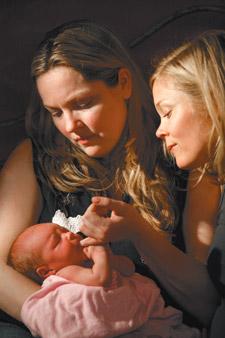
FAMILY WAY. Megan Fahlenbock and Angela Vint star in The Baby Formula, opening Fri, Jun 19 at AMC Yonge and Dundas.
Alison Reid has had more than her fair share of pregnant bellies. The director had to deal with two pregnant lead actresses in her first feature film, The Baby Formula. This came with its own unique problems. “We were actually rehearsing the scene when [Athena’s] water breaks and [the actress’s] water breaks in real life,” says Reid laughing enthusiastically. The actresses leapt at the chance to use their pregnancies to advantage. “Usually in this industry you’re trying to hide your pregnancy as an actress,” says Reid.
Having played dozens of festivals worldwide, including Toronto’s Inside Out where it just won both the audience fave feature award and the juried best acting award (a tie for Angela Vint and Megan Fahlenbock), The Baby Formula is one of the few lucky Canadian films to open on the big screen (beginning Fri, Jun 19 at AMC Yonge and Dundas).
The movie follows lesbian couple Athena (Vint) and Lilith (Fahlenbock) as they use the latest in stem-cell research to have a baby together. That is, they use each other’s stem cells in order to create sperm for each other—meaning no father and they’re both the biological parents of both children.
But the film veers away from too much scientific mumbo jumbo and ends up being a family comedy, replete with spousal bickering, difficult parents and a good wallop of dysfunction.
“Despite how anyone gets pregnant,” says Reid, “the things that we’re dealing with are more similar than dissimilar. Once you see those two women how could you possibly object to them wanting their own baby together. You see how much they want it and you see how much they’re going through. So we did it in an accessible, nonthreatening kind of a way.”
The Baby Formula marks Reid’s debut as a feature director. She is known more in the business as a stunt performer and coordinator with credits ranging from X-Men: Last Stand and Blindness to Degrassi: The Next Generation. Her new feature expands on the story from Reid’s directorial debut, the 2006 fictional short Succubus (also starring Vint and Fahlenbock). Having two pregnant actresses play pregnant characters allowed Reid to capture on camera some wonderfully real, impromptu and improvised moments.
The Baby Formula’s mockumentary approach to its subject matter is energizing — although it caused confusion with some viewers. “People asked: Are they really a couple? How did they get pregnant?” she says, smiling. In fact, the film was so convincing that it was erroneously given a documentary award at the Monaco Film Festival.
She also points out how the film is being distributed for its crossover appeal. “The queer community has been able to relate to and identify with straight characters for years — laugh with them, cry with them. And now it seems that we’re getting to a place where the sexuality of the main characters doesn’t prevent anyone from identifying with them — which is fantastic.”
The science portrayed in the movie is based on studies done with mice and is mild science fiction in that it is not yet available for humans. “I’m sure it’s going to be reality. We’re going down that path and it’s going to be possible,” says Reid, noting it’s an issue to some because “we haven’t wrapped our brains around [the concept] yet. Test-tubes babies used to be controversial. It’s because it was the first time it was done, now it’s commonplace.”
One of the movie’s great lines comes from the scientists: “We’re not making men obsolete, we’re making them unnecessary.” Some male viewers took that to heart with Reid. “I always find that funny… it’s not saying men shouldn’t have babies, or men shouldn’t be involved in having babies, it’s about opening up the possibilities — now women can have babies together too.” She smiles.

 Why you can trust Xtra
Why you can trust Xtra


